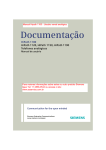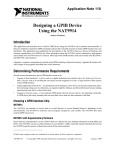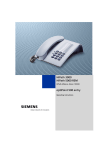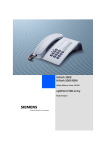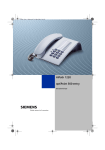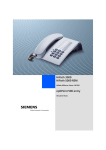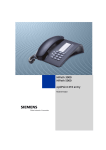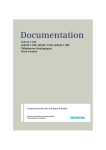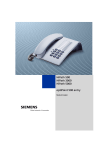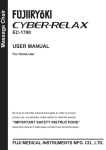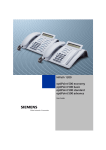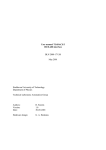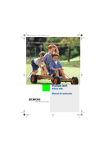Download HiPath 1100 HiPath 1120 HiPath 1150 HiPath 1190
Transcript
KBA.book Seite 1 Freitag, 26. Januar 2007 9:37 09 HiPath 1100 HiPath 1120 HiPath 1150 HiPath 1190 System Telephones optiPoint 500 economy optiPoint 500 basic optiPoint 500 standard optiPoint 500 advance Quick Reference Guide KBA.book Seite 2 Freitag, 26. Januar 2007 9:37 09 Explanation of symbols Symbol Explanation ll, q, p ... Enter numbers, keys, password, internal or external numbers, etc. w Signaling with a short beep n/t Lift/Replace the handset s Start conversation Service Menu Service Menu Programmable key is ON Programmable key deleted Blinking Programmable key < > and : Navigation keys Numbering Plan Description External line HiPath 1120 HiPath 1150 HiPath 1190 801 to 808 801 to 832 801 to 845 11 to 30 11 to 60 610 to 645 101 to 240 Extension, including S0 Group of external lines 0, 890 to 899 Internal subscriber group 770 to 779 Hunt Groups (HG) 780 to 789 UCD subscriber group 790 to 799 Carrier 9 EVM - Default internal number 790 EVM - Message Ports 7491 to 7492 EVM - Virtual ports 744 to 747 Fax/DID - Virtual message ports 740 to 743 USB/CAPI line 10 Substitution for * and # 75 and 76 (accordingly) 2 100 KBA.book Seite 3 Freitag, 26. Januar 2007 9:37 09 Display indications optiPoint 500 1 2 • • 06:30 27 SEG 03.OUT 05 HiPath 1100 > Line 1 displays time, date, requests, error messages and confirmation messages, as appropriate. Line 2 displays the internal number, system name, and available options that can be selected by pressing :. If the ">" appears on the right, it means there are more options available. Options can >. be accessed using < and Configuring the keys The key layout is shown below. The remaining keys are available for programming. Notes: The Mute/Internal key will function as Internal when Automatic seizure of an external line is activated. In all other cases, the Mute/internal key functions as Mute. See the User Manual (A31003-K1160-B801-*) or the HiPath 1100 Manager for information on how to program keys. Labels for programmable keys can be printed/changed using the "Printing Labels" service on the HiPath 1100 Manager. System telephone settings can be configured individually according to each user’s preferences. For further information on how to configure a system telephone, see the manual included with the unit. Feature Features can be selected as follows: 1. Using the navigation keys in the Main Menu 2. Using the Service Menu key then browsing the feature option list 3. Using the Service Menu key and the appropriate feature code 4. Programmable key 5. Using the feature code System telephone functions Accessing a mailbox Call charge consultation Mailbox key programmed for MWI qji p Call forwarding Call forwarding Call forwarding Deactivation Call forwarding Parking Parking d to m slot Parking Resuming a call Parking d to m Caller List rlf < > list : 3 slot KBA.book Seite 4 Freitag, 26. Januar 2007 9:37 09 Programming a feature for a key qme <> Select a key feature to be programmed and : Redial Speaker Redialing Activate/deactivate speakerphone Speaker Activate/deactivate speaker s Headset Speaker Activate/deactivate headset Activate headset Checking relay status qmheh Admin of extension names (1 optiPoint with system display) qmhmi p PIN extension System Speed Dial or extension/group Seizure of an external line Feature Code External call dp External call using a group of external lines lmd.lmm p external line Seizure of a specific external line lde.lhi p Internet Access Activation qhmg p external line Internet Access Deactivation rhmg p external line External line reservation Busy 1)Wait for w t Phone rings n p external s or qil 2)Wait Service Menu t Phone rings n p external s Functions used when making calls Feature Code System speed dialing qk + ddd . fhm Individual speed dialing qk + qd.qh s Individual speed dialing Programming qmf + qd.qh Speakerphone auto-answering mode Activation Speakerphone auto-answering mode Deactivation CHANGE? : p number SAVE? : wait w qmjwait for w rmj wait w 4 KBA.book Seite 5 Freitag, 26. Januar 2007 9:37 09 Direct communication call qld p extension with a system telephone Internal call p extension Calling a call group (CG) kkd . kkmV Calling a Hunt Group (HG) kld . klm UCD subscriber group kmd . kmm Urgent call (busy extension) 1) wait for or 2 w s record message n p (busy) Wait for w s n p (extension) Service Menu qil s Hotline (If programmed) ns Warmline (If programmed) n Wait Override Busy extension p (busy) s qjf s Service menu LCR Bypass qhi p Carrier + number s View timeout rji Silent monitoring busy extension qmhh p busy extension s Recall Activation (Extension does not answer or is busy) 1) p no answer RECALL? : or qil w . Wait. Phone rings or 2) Wait for w t. Wait. Phone rings ns ns Callback Deactivation ril Carrier m Using a temporary MSN to make a call qhe p MSN slot or MSN number p external line p external number Functions used during calls Feature Code Account code qjd Conference s Consultation p number s Service menu qg s s Consultation s Service menu Consultation (To end a consultation, wait for the call to be disconnected) Parking 5 p account code r p number ps qij+d.m KBA.book Seite 6 Freitag, 26. Januar 2007 9:37 09 Retrieving a parked call rij + d.m s General Parking s Retrieving a parked external call qjg Toggle (Use after consultation, for answering a second or urgent call) Suffix dialing Retrieving a call on hold s t Gen. Parking + p line s qf s Service menu s + p data qd Service menu if busy or no answer Transfer (When an external analog line programmed as “Type of answering signal” or a digital line is being used, you must wait for an answer before transferring the call. For transfers without consultation, there is no need to wait before answering) Internal s p extension t External s<> : TRANSFER? p number (s) Functions used when receiving calls Feature Code Accessing a mailbox p Voice mail group Answering Call waiting Service menu or s qii qf s Service menu or CALL WTNG? Group pickup : qik or CALL 4 PCKP GRP? Individual pickup : qim p extension Call forwarding on an analog line: Call forwarding to external number qee p external : Internal call forwarding qee p extension, voice mail group, call group or Fax/DID : Call forwarding Deactivation ree Call forward no answer or busy Activation qeh p extension,voice mail group , Call group or external line Call forward no answer or busy Deactivation reh Do not disturb Activation qmk Do not disturb Deactivation rmk 6 KBA.book Seite 7 Freitag, 26. Januar 2007 9:37 09 EVM: Consultation at the extension being used kmd VM group p password Consultation from another extension kmd VM group p password p extension s Consultation from an external extension s p your external number + q p password p extension Miscellaneous functions Feature Entrance telephone Door opener Code qje Service menu or Service menu qje p extension General alarm Deactivation rmheh p password Electronic lock password change qmhg p current password p new password p confirm new password w Electronic lock Activation qjj Electronic lock Deactivation rjj p password Busy signal when extension is busy Activation qmhee : Busy signal when extension is busy Deactivation rmhee System programming mode Activation qmi p password p codes Deactivating features (call forwarding, do not disturb, data protection, alarm clock, callback and speakerphone auto-answering) rd Language/Country settings qmhef p country code Call Group (CG) and Hunt Group (HG) Login qli p group (if it belongs to more than one group) Call Group (CG) and Hunt Group (HG) Logout rli p group (if it belongs to more than one group) Room monitor (Babyphone) qll Music on Hold Activation qmhed Music on Hold Deactivation rmhed Remote configuration HiPath 1100 Manager qmmf 7 p password Music KBA.book Seite 8 Freitag, 26. Januar 2007 9:37 09 Remote configuration Using an MF telephone 1) The local programming extension is talking to the remote programmer: qmme w t Remote programmer must provide: p password p programming codes. 2) The remote programmer dials the system and is attended by the Fax/DID feature: qmi p password p programming codes. Data protection Activation qhmd Data protection Deactivation rhmd Relay Activation (only for HiPath 1120) qmd Relay Activation (only for HiPath 1120) rmd Night service Activation qhh p password Night service Deactivation rhh p password Call Waiting tone Activation n rlk w t Call waiting tone Deactivation n qlk w t COS (Class of service) Changeover qidl p extension p password s Alarm clock Feature Code Alarm clock (Daily) qhje p time (e.g 1230) : Alarm clock (Daily, except weekends) qhjf p time (e.g 1230) : Alarm clock (After a specified time period) qhjg p time (e.g 1230) : Alarm clock (For a specified date and time) qhjh p date/time (e.g 24121830) : Alarm clock Deactivation rhj : UCD subscriber group functions Feature Code Agent available qhdf Agent unavailable rhdf Calling a UCD subscriber group kmd.kmm Logging into a UCD subscriber group qhde p group (if the extension belongs to more than one group) 8 KBA.book Seite 9 Freitag, 26. Januar 2007 9:37 09 Logging out of a UCD subscriber group rhde UCD agent in service qhdg UCD agent out of service rhdg Show queue size to UCD agent qhdi Satellite PABX Feature Flash on external analog line Operation as a Satellite PABX Code Service menu qie lmd.lmm p line number Special functions for ISDN lines Feature Code Immediate call forwarding for MSN Activation qjhe p external w p MSN Immediate call forwarding for MSN Deactivation rjhe w Call forwarding - no answer, for MSN Activation Call forwarding - no answer, for MSN Deactivation Call forwarding for MSN when the line is busy Activation Call forwarding - Busy, for MSN Deactivation qjhf p external w p MSN rjhf w qjhg p external w p MSN rjhg w Service menu Caller ID (Trace) qlh Restriction for sending MSN Activation qlj Restriction for sending MSN Deactivation rlj Using features provided by a carrier over an ISDN Network qidg p external p ISDN code Note 1: For Korea the numbering plan changes as follows: a) Access to the group of external lines is done with digit "9" instead of "0" b) Calling an operator terminal is done with digit "0" instead of "9" c) Group call pickup is done with sequence "*0" instead of "*57" d) Recovery of a parked call is done with sequence "*57" instead of "*0" Note 2: Feature Codes can be changed with the HiPath 1100 Manager. An expert should be consulted in this case. 9 KBA.book Seite 10 Freitag, 26. Januar 2007 9:37 09 www.siemens.com/enterprise The information provided in this document contains merely general descriptions or characteristics of performance which in case of actual use do not always apply as described or which may change as the result of further development of the products. An obligation to provide the respective characteristics shall only exist if expressly agreed in the terms of the contract. All trademarks are the property of Siemens Enterprise Communications GmbH & Co. KG or their respective owners. © Siemens Ltda. Siemens Communications Rua Pedro Gusso, 2635 • Curitiba-PR/BR Ref. No.: A31003-K1270-U107-2-7619 Subject to availability. Right of modification reserved. 26.01.2007 V6.0











